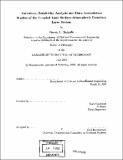Variational sensitivity analysis and data assimilation studies of the coupled land surface-atmospheric boundary layer system
Author(s)
Margulis, Steven A. (Steven Adam), 1973-
DownloadFull printable version (9.495Mb)
Other Contributors
Massachusetts Institute of Technology. Dept. of Civil and Environmental Engineering.
Advisor
Dara Entekhabi.
Terms of use
Metadata
Show full item recordAbstract
One of the fundamental components of Earth system science is understanding coupled land-atmosphere processes. The land plays an especially important role in the climate system principally via the regulation of surface fluxes of moisture and energy into the atmosphere. Due to the mutual dependence of these fluxes on surface and atmospheric states, the land and boundary layer comprise a coupled system with complicated interactions and feedbacks which are significant factors in modulating the variability of the weather and climate. In this thesis we develop a framework for exploratory sensitivity analysis and data assimilation in the coupled land-atmosphere system using a variational (or adjoint) approach. The framework is applied to three distinct case studies of interest. First, the variational framework is used to quantify land-atmosphere coupling and feedbacks. The model and its adjoint are used to investigate the differences in the daytime sensitivities of land surface fluxes to model states and parameters when used in coupled and uncoupled modes. Results show that the sensitivities between the two cases are significantly different because of boundary layer feedbacks. Depending on the particular case, sensitivities can be either amplified or dampened due to the presence of an interactive boundary layer. Next, we used the variational data assimilation framework to investigate the potential of estimating land and ABL states and fluxes from readily-available micrometeorological observations and radiometric surface temperature. (cont.) Results from an application to a field experiment site showed that using both surface temperature and micrometeorology allows for the accurate estimation of land surface fluxes even during non-ideal conditions. Furthermore the assimilation scheme shows promise in diagnosing model errors that may be present due to missing process representation and/or biased parameterizations. Finally, a combined variational-ensemble framework is used to estimate boundary layer growth and entrainment fluxes. The results from our application to the field site indicate a much larger ratio of entrainment to surface fluxes compared to early literature values. The fact that the entrainment parameter is larger than first hypothesized serves to further bolster the importance of land-atmosphere coupling.
Description
Thesis (Ph.D.)--Massachusetts Institute of Technology, Dept. of Civil and Environmental Engineering, 2002. Includes bibliographical references (p. 197-205).
Date issued
2002Department
Massachusetts Institute of Technology. Department of Civil and Environmental EngineeringPublisher
Massachusetts Institute of Technology
Keywords
Civil and Environmental Engineering.